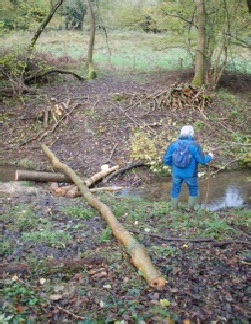
Two of us joined Chris Uttley, RSuDS Project Officer for SDC, as he took a group of local people to the top of the Slad Valley to see the innovative work being undertaken to eventually prevent torrential flooding along the Slad & Painswick watercourse. Everyone is living in an area where flooding has happened in recent times, some of them with considerable damage to their properties. We, in Eastington, are of course downstream from that part of the Frome & therefore need to take note!
It wasn’t raining on that morning but, as we all know, it had been pretty heavy in previous days so we needed waterproofs, wellies and walking poles to wend our way across & through woods & mud.
Chris was introducing us to the facts about the potential risks of ‘Boscastle-like’ flooding within one or two of the Stroud Valleys unless sufficient work is carried in the next few years to set up systems that can alleviate these risks.
Chris was introducing us to the facts about the potential risks of ‘Boscastle-like’ flooding within one or two of the Stroud Valleys unless sufficient work is carried in the next few years to set up systems that can alleviate these risks.
We were shown how the techniques that have been considered, and are being installed,include permanent/semi-permanent designs that will collect, store & treat water resulting in a slower release into the environment. Designs tend to have a low cost, low energy
input with low maintenance costs & result in positive impacts on the environment.
They are typically located in three main areas depending on their design: in-channel, across flood plains & land areas or across farmyard areas.
We were looking at one method of ‘in-channel’ system to develop barriers with woody debris which result in reducing the speed of water flow & the collection of water into small pools upstream of the barrier.
The photos show how large logs are used to make these barriers – they are strategically placed, drilled & fixed in place with metal poles at least 6ft in length hammered through the wood & down into the ground.
The continuing support for this work from the County Council is vital to prove its viability and to provide alleviation in the sensitive rapid reaction catchments of the Frome catchment.
There are many designs that can be found in the following documents:






















